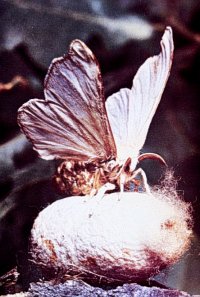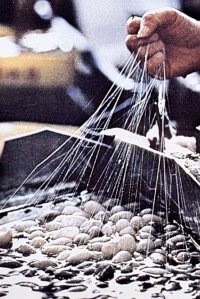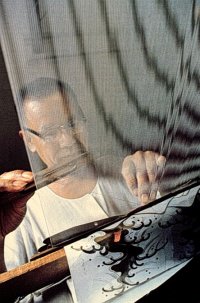Sericulture

Silkmoth (Bombyx mori) on its cocoon
According to Chinese legend, silk was first discovered in 2640 BC by Xilingji (Hsi-ling-chi), the 14-year-old wife of China’s third emperor, Huangdi (Huang-Ti). One day, as she was making tea in the palace garden, Xilingji accidently dropped a silkworm cocoon into a cup of hot water and discovered that the silk fiber could be loosened and unwound. By twisting together fibers from several cocoons, she made a thread that was strong enough to be woven into cloth.
No one is certain how much of this delightful story is true, but the practice of sericulture (rearing silkworms for the production of raw silk) is certainly older than recorded history. For centuries, it was the Chinese nobility’s most closely guarded secret. Only members of the royal family were permitted to wear garments made of silk. But as the laws regulating sericulture were gradually relaxed, explorers and traders began to acquire enough samples of the fabric to create a demand for it in the West. For a while, Persia became China’s trading partner, buying silk and reselling it to the Europeans at exorbitant prices. By the time the Han dynasty finally authorized direct trade with Europe (around 140 BC), there was an eager market for the fabric throughout most of the Roman Empire. Despite constant danger from thieves, the Silk Road, a perilous overland trade route through Asia Minor, came to be a major cultural link between the two continents.
 The silk trade made China a wealthy and powerful country. But according to legend, the Roman Emperor Justinian balked at paying China’s high prices for silk. Around 550 AD, he recruited two Persian monks and sent them into China as spies to learn the secrets of silk production. Two years later, the monks returned to Constantinople (now Istanbul) with silkworm eggs and mulberry seeds concealed within their hollow bamboo canes. The Turks quickly established their own silk industry and broke China’s monopoly. The techniques of sericulture spread throughout the Mediterranean countries during the 7th century AD and then into Spain and Sicily following the Saracen invasion. By the 12th century, Italy had become the silk capital of the West, and later, the French government spawned its own industry by subsidizing farmers who planted mulberry orchards.
The silk trade made China a wealthy and powerful country. But according to legend, the Roman Emperor Justinian balked at paying China’s high prices for silk. Around 550 AD, he recruited two Persian monks and sent them into China as spies to learn the secrets of silk production. Two years later, the monks returned to Constantinople (now Istanbul) with silkworm eggs and mulberry seeds concealed within their hollow bamboo canes. The Turks quickly established their own silk industry and broke China’s monopoly. The techniques of sericulture spread throughout the Mediterranean countries during the 7th century AD and then into Spain and Sicily following the Saracen invasion. By the 12th century, Italy had become the silk capital of the West, and later, the French government spawned its own industry by subsidizing farmers who planted mulberry orchards.
 The English started making silk in the 13th century, but their cool, damp climate hindered progress. The practice spread to the American colonies in 1603 when silkworm eggs and mulberry seeds were sent to Virginia by order of King James I. Silk was produced erratically in Virginia and Georgia during the early 1700’s, but tobacco and cotton proved to be more economical. In North Carolina, the town of Silk Hope in Chatham County was apparently named for the efforts of a local farmer who tried to raise silkworms shortly after the Revolutionary War. His endeavor ultimately failed because the silkworms wouldn’t eat the type of mulberry he tried to grow on his farm. Nathaniel Aspinwall had better success around his home town of Mansfield, Connecticut. He started raising silkworms about 1760 and the practice soon spread throughout the community. A series of silk mills, first built in 1810, helped mechanize the industry and for nearly 100 years the Mansfield area led the country in silk production. Unfortunately, the industry was plagued by fires and bankruptcies. The last of the mills closed around 1960.
The English started making silk in the 13th century, but their cool, damp climate hindered progress. The practice spread to the American colonies in 1603 when silkworm eggs and mulberry seeds were sent to Virginia by order of King James I. Silk was produced erratically in Virginia and Georgia during the early 1700’s, but tobacco and cotton proved to be more economical. In North Carolina, the town of Silk Hope in Chatham County was apparently named for the efforts of a local farmer who tried to raise silkworms shortly after the Revolutionary War. His endeavor ultimately failed because the silkworms wouldn’t eat the type of mulberry he tried to grow on his farm. Nathaniel Aspinwall had better success around his home town of Mansfield, Connecticut. He started raising silkworms about 1760 and the practice soon spread throughout the community. A series of silk mills, first built in 1810, helped mechanize the industry and for nearly 100 years the Mansfield area led the country in silk production. Unfortunately, the industry was plagued by fires and bankruptcies. The last of the mills closed around 1960.
During the twentieth century, the high cost of western labor, a shortage of mulberry leaves, world wars, and two silkworm diseases (pebrine and flacherie) have conspired to reduce the size and scope of western sericulture. Today, most commercial silk production is confined to China and Japan where it remains largely a cottage industry. India is still a major producer of “wild” (Tussah) silk.

